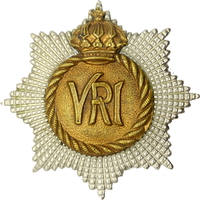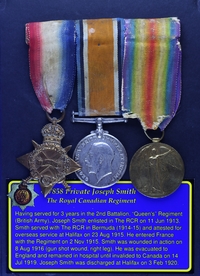
477858 Private Joseph Smith
The Royal Canadian Regiment
By: Capt (ret'd) Michael M. O'Leary, CD, The RCR
Joseph Smith was born 27 Jun 1886 in London, England. While in Bermuda with The Royal Canadian Regiment (1914-15), Joseph Smith identified his next of kin as his father W. Smith, who was living at 33 Standard St., North Kent Rd., London, England. Later, in August 1915 when he attested for overseas service with the Canadian Expeditionary Force, Smith had changed his reported next of kin to his mother (at the same address).
Joseph Smith enlisted in The RCR at Halifax, Nova Scotia, on 11 Jun 1913 and was given the Permanent Force regimental number 9693. He reported prior service of 3 years with the British Army, 2nd Battalion "Queen's", but his dates of Imperial service are not recorded in his Canadian records. Smith served at Halifax, and in Bermuda (1914-15) with The RCR before attesting for overseas service on 23 Aug 1915. At the time of his attestation, Smith was described as: age 29 years; height 5 ft 5 in; girth 36 1/2 in; complexion fair; eyes brown; and hair brown. He gave his trade as "Labourer."
Smith arrived in France with The RCR on 2 November 1915, disembarking at Boulogne. Although he served throughout almost the entire war with The RCR, his service records are notably for their lack of entries. Very probably he was a solid soldier, with only one disciplinary incident recorded, and he managed to escape serious injury until very late in the war.
In late January 1917 Smith was granted 10 days leave, from which he returned on 9 February 1917. Later that month, on 27 February 1917, he was at the final day for the 3rd Canadian Division's divisional sports held at Bruary. The Regiment's War Diary reads:
"BRUAY - 27 February 1917 - Cool and Cloudy. Syllabus adhered to all day, Battn. marched to training area (No. 16 Squadron R.F.C. aerodrome) and worked from 9.00 A.M. to 12.00 Noon and 1.00 P.M. to 3.00 P.M., kitchens were taken up and troops had noon meal on grounds. Bombing and Bayonet Fighting competitions at MARLES-LES-MINES. Our bombing team did not do well, but our bayonet fighting team were third in the Division. Finals of the Divisional Boxing at 6.00 P.M. Sergt, Symons was knocked out in second round. On points he was winning easily, but he unfortunately walked into a wild punch on the point of his jaw."
Private Joseph Smith's performance at the games was also noted, but he did not return to the unit lines with any sporting trophies. Rather, he came back under a black cloud and on charge. The next day, 28 February 1917, saw Smith brought before Capt C.G.B. Thompson (later M.C. (1918) and bar (1919)) on a charge of Drunkenness, in that he committed "neglect of duty while in charge of cook wagon." The witness to the offence was C.S.M. Wyatt (later D.C.M. (1918) and post-war R.S.M. (1924)). Smith was found guilty of the offence and awarded a punishment of 7 days Confinement to Barracks. The Regiment remained at Bruay long enough that Smith was not to escape his punishment by a return to the front lines.
On 15 November 1917 Smith was admitted to No. 11 Can Field Ambulance. Diagnosed with "myalgia" (muscle pain) of the legs, he progressed to the 12 Canadian Field Ambulance, then the 98 Field Ambulance, from which he was discharged to duty on 25 November 1917. He rejoined The RCR in the field on 28 November.
Private Smith was granted another leave period on 27 December 1917, this time for 14 days and the destination was recorded as England. He rejoined from leave on 20 January 1918.
On 8 August 1918, The RCR entered the battle of Amiens. The official history of the CEF describes the battalion's actions:
Promptly at 8:20 the attack was resumed, Brig.-Gen. Dyer sending forward the 49th Battalion on the left, the 42nd in the centre, and The Royal Canadian Regiment on the right astride the Roye road. Progress was rapid. The 49th Battalion, meeting little opposition in its advance across the unfenced fields of standing grain, reached the Red Line at ten o'clock. In the centre the 42nd, having overrun two German batteries that were engaging it with point-blank fire, crossed over the plateau of Hill 102 and arrived on its objective with four supporting tanks at 10:20. The last part of the advance, wrote the regimental historian, "was more or less of a route march enlivened by the sight of the panic-stricken enemy running in every direction".
Meanwhile the R.C.R., proceeding with "something approaching the clock like precision of a well rehearsed manoeuvre", was already on its objective, having cleared two woods with the assistance of the few surviving tanks.
On the Canadian Corps' right the Franco-Canadian liaison detachment, while maintaining contact between the 3rd Canadian and 42nd French Divisions' flanks, had contrived to clear a small copse south of Rifle Wood, taking thirty prisoners and a dozen machine-guns. On reaching the Green Line the original Canadian component rejoined its parent unit (the 43rd Battalion) and was replaced by a platoon from the R.C.R.
The 3rd Division had completed its assignment, though of its original 42 tanks only eight remained. The final infantry advance to the Blue Dotted Line on this part of the front was to be made by the 4th Canadian Division.
From the narrative recorded in the Regiment's War Diary, the following details were noted:
8.20 a.m. Battalion jumped off. Battalion Headquarters temporarily established in HAMON WOOD.
9.10 a.m. Word received from both Front Line Cos. that they were clear of VALLEY and JEAN WOODS. Enemy not putting up very strong fight.
10.30 a.m. Word received that LEFT Company had reached Objective. Captured three Field Guns, 6 Machine Guns and seventy prisoners. Casualties - EIGHT.
10.45 a.m. Word received that RIGHT Company had reached Objective. Captured 3 Field Guns, eight Machine Guns and ninety prisoners. This Company met with considerable opposition and some stiff fighting ensued. Casualties - TWENTY-SIX.
Joseph Smith was one of those soldiers wounded on the 8th of August 1918. Suffering a gun shot wound to his right leg, he was evacuated to the Casualty Clearing Station.
Smith's injuries were serious enough that he was evacuated to England, and would be subjected to a lengthy period of orthopaedic treatment. On evacuation to England, Smith was first admitted to Queen Mary's Military Hospital, Whalley, Lancashire, (13 Aug 1918) then to G.C. Special Hospital, Buxton, (13 Feb 1919), and finally to 5 Canadian General Hospital, Kirkdale (5 Jul 1919).
On 14 July 1919, Smith was invalided to Canada, his departure from England recorded on sailing List 508 embarked for Military District No. 6, Halifax, Canada. He was taken on strength No. 6 District Depot as of 14 July and posted to the Hospital Section. On 3 February 1920 he was transferred to the Casualty Company and then struck off strength by being discharged the same date.
On 3 February 1920, Private Joseph Smith was discharged, medically unfit, from the Canadian Expeditionary Force, at Halifax, N.S. He was 33 years, 7 months, old at the time of his discharge.
Pro Patria
Visit a randomly selected page in The O'Leary Collection (or reload for another choice):
- The O'Leary Collection; Medals of The Royal Canadian Regiment.
- Researching Canadian Soldiers of the First World War
- Researching The Royal Canadian Regiment
- The RCR in the First World War
- Badges of The RCR
- The Senior Subaltern
- The Minute Book (blog)
- Rogue Papers
- Tactical Primers
- The Regimental Library
- Battle Honours
- Perpetuation of the CEF
- A Miscellany
- Quotes
- The Frontenac Times
- Site Map
QUICK LINKS
The O'Leary Collection—Medals of The Royal Canadian Regiment
Newest additions:
![]()
![]() SB-12725 Private Henry "Hank" Ard
SB-12725 Private Henry "Hank" Ard ![]()
WIA at Hill 187, Died of Wounds in Japan
![]()
![]() 2355331 Lance Corporal Albert Lorking
2355331 Lance Corporal Albert Lorking
Wounded in action, later a War Amps representative.
![]()
![]() 4334 / 477996 Pte Isaac Hamilton Wilcox
4334 / 477996 Pte Isaac Hamilton Wilcox
Permanent Force, South Africa, and C.E.F.
![]()
![]() 477019 Private Harold Ashcroft
477019 Private Harold Ashcroft
Transferred to the Tunnelers.
![]()
![]() 734231 Private Clark D. Thompson
734231 Private Clark D. Thompson ![]()
The older Thompson brother, killed in action.
![]()
![]() 733849 Private Norman Parker Thompson
733849 Private Norman Parker Thompson
The younger Thompson brother; post-war service in the Special Guard.
![]()
![]()
![]() A305 / 400305 Private Andrew Walker
A305 / 400305 Private Andrew Walker ![]()
"Previously reported Wounded, now Killed in Action."
![]()
![]() 823298 Pte Thomas Patrick Steele, M.M.
823298 Pte Thomas Patrick Steele, M.M. ![]()
… for gallant conduct in the field …
![]()
![]() P13066 Sergeant Harold Thompson
P13066 Sergeant Harold Thompson
Instrumental Soloist for over 20 years of Canadian Army service.
![]()
![]() 9609 / 477728 Private Albert Edward Piper
9609 / 477728 Private Albert Edward Piper
"Arrived from England as a STOWAWAY …"



